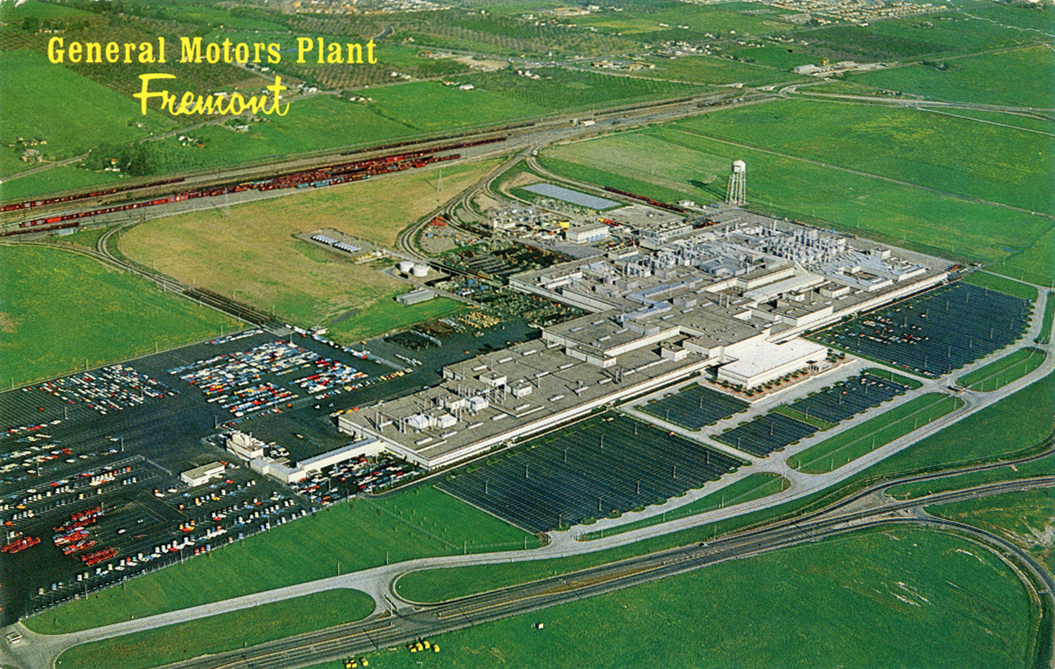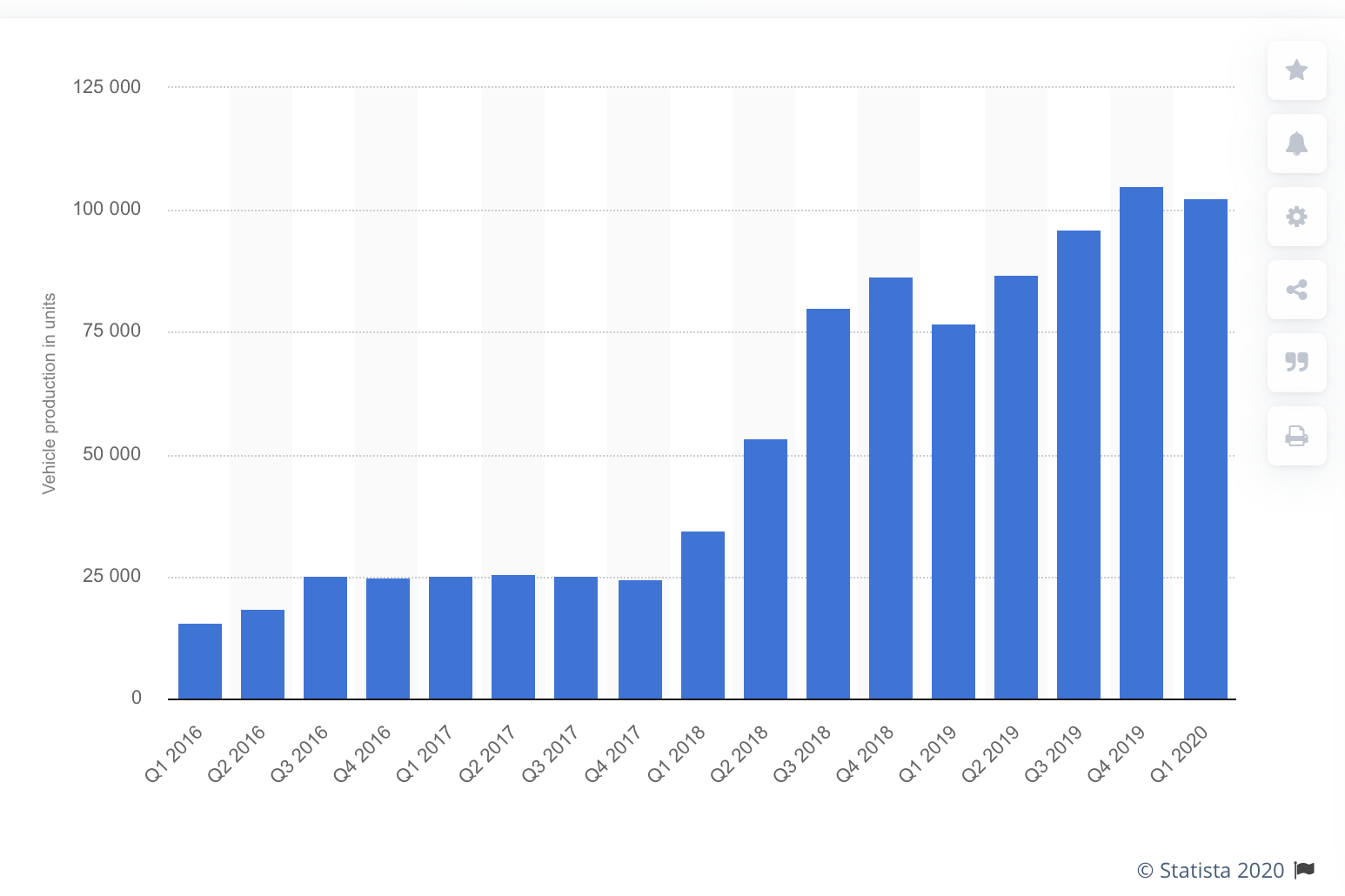On this blog, I have always been cautiously positive about Tesla. I think that electric cars are great, and Teslas are well-designed electric cars. I have consistently argued that Tesla is solving operational problems that take time. Operational improvements are gradual but they have tremendous payoffs by steady accumulation.
To understand Tesla’s operations, I have argued for the need to evaluate Musk and Tesla separately with a dispassionate eye.
Recently, Musk was again in the news due to his tweets — probably not his most famous or costliest tweet ever — for threatening to move Tesla HQ out of California and the manufacturing out of the Fremont CA plant. Supply chains and production has been sputtered in the US and elsewhere. Maintaining idle plants is indeed prohibitively expensive. I don’t intend to parse Twitter statements. There is a lawsuit against Alameda County’s shelter-in-place rules, while NY Times reports that based on parking lot data the Fremont plant is running (and Musk intends to escalate the confrontation). The tweetstorm however gave yet another opportunity for American politicians to signal their adherence to their “principles”. Texas Governor Greg Abbott responded with “emoji eyes” with some glee. CA Assemblywoman Lorena Gonzalez responded with an expletive. Another data point on how complex issues get muddled into inelegant put-downs on Twitter.
I don’t intend to parse Twitter statements. There is a lawsuit against Alameda County’s shelter-in-place rules, while NY Times reports that based on parking lot data the Fremont plant is running (and Musk intends to escalate the confrontation). The tweetstorm however gave yet another opportunity for American politicians to signal their adherence to their “principles”. Texas Governor Greg Abbott responded with “emoji eyes” with some glee. CA Assemblywoman Lorena Gonzalez responded with an expletive. Another data point on how complex issues get muddled into inelegant put-downs on Twitter.
Financial Post has argued that “Moving the headquarters and future programs to Texas and Nevada, where Tesla has its massive battery plant, is a threat that would be relatively easier for Musk to follow through on.” Is it true? This allows us to look at the NUMMI plant and whether moving the production is “easy”.
California, NUMMI, and The Value of Workforce.
First, Tesla is indeed the last carmaker left in CA. In general, CA is not a great location for manufacturing. If we were to locate a plant on the US map now, one wouldn’t pick Fremont CA as a manufacturing location. Many reasons: costs, the often (overly) derided regulatory environment, the exorbitant real estate, high wage rates, etc.
Yet, the NUMMI (New United Motor Manufacturing Initiative) plant in Fremont, CA where Teslas are made, was one of the most successful manufacturing joint ventures attempted. It was a cross-continental GM-Toyota joint venture that was shut down in 2010, only in the terrible aftermath of the 2009 recession when GM pulled out. Musk’s business acumen in buying the plant at basement prices has been well recorded, and even often (correctly) touted by many of his fans.
From 1962 to 1982, NUMMI was a GM plant with a pretty terrible production record. The town of Fremont itself was large tracts of farming land.

It was in 1984, that GM and Toyota started the NUMMI joint venture. There were good objectives on both sides: Toyota wanted to get a footprint in America. (NUMMI preceded Toyota’s first American TMMK plant in Kentucky by 4 years). GM hoped to successfully adopt the Toyota Production System into the GM Supply chain. While the NUMMI plant adopted many of the lean manufacturing principles, GM was not successful in evangelizing the practice across all its plant. But, Nummi was steadily chugging along making cars mainly, Pontiac Vibe, Toyota Corolla, and Tacoma. (See below). Eventually, in 2009, GM pulled out, and Toyota shifted its production to other plants in the United States.

When GM quit on the heels of the 2009 downturn, the line was getting set to manufacture a GM version of the Toyota Prius. Therefore, acquiring the NUMMI plant has been a boon for Tesla, because the line was exactly setup for making cars under the Toyota Production System. (Tesla later deviated from the Toyota Production System).
While the plant was chugging along, Fremont itself grew and morphed into the Greater Bay Area, which now is expanding inland across the mountains into Pleasanton and Livermore.
Despite the costs, I would argue that a distinct advantage that Bay Area offers in spades is labor supply and ideas that come along with it. The market is competitive due to a constant supply of engineers and scientists from universities and immigration into the state and the country. Despite the escalating costs, Bay Area provides exciting educational, entrepreneurial, and environmental benefits to many working couples — as college grads increasingly marry college grads. Because Tesla production needs many engineers (both hardware and software) being located in California has been a bounty. Most of the difficult problems Tesla has solved have been associated with design (hardware and software), manufacturing process, and production management (industrial engineering).
Even a valid critique of “bad governance“ in California cannot ignore the strength of the Bay Area as a large base of supply and a competitive work environment. You can see this same issue play out in another location, where Tesla is now building cars — Shanghai. Highly regulated location, but also a rich source of trained labor supply. On my visit, executives of many EV makers in Shanghai repeatedly emphasized how despite how “capable labor force“ is one of the most important reasons to be located in Shanghai.
On a related note, the Tesla Shanghai plant was shut down by the Chinese Government in February for several days due to COVID and was steadily reopened. So, Tesla has some experience in running the plan post-COVID although, I wonder how much knowledge can be transferred. Shanghai plant is currently idling due to component shortage.
To wrap up, by locating away from the Fremont plant, Tesla loses access to two things:
- A plant designed for producing cars, and which is now capable of producing 5000 cars a week, after emerging from a production hell.
- Access to Bay Area labor force that is immediately available (and due to working couples in often in different jobs, a trained workforce who cannot shift their lives to Nevada).
Unbearable Burden of Getting New Plants to Work
Finally, a fairly well-known point that is nevertheless worth stressing. It is not easy to shift production to a new location. More than anyone else, Elon Musk is aware of “the production hell” Tesla went through, even with the best-of-its-kind workforce. As the chart shows, the production growth at Fremont took a while to hit healthy targets. (Btw, compare unit production in the two charts. It is not an apple to apple comparison, but still quite informative. Fremont plant has a ton more capacity).

Even with best-made plans and noblest intentions, building a factory and shifting capacity can go wrong, and take time to fix, as it is often a complex undertaking involving thousands of people. The Oscar-winning documentary American Factory (in which a Chinese glass manufacturer, Fuyao Glass, opens a plant in Moraine Ohio to be geographically closer to buyers) is a great example of the complexity of shifting capacities.
Sometimes, even the plants designed to make automobiles are not flexible enough to manufacture new models. In my class, I often talk about a famous PT Cruiser example from 20 years back, but whose lessons are relevant for this discussion. (Full article at WSJ).
In the car industry, the Chrysler assembly plant here in the farmland west of Chicago is known for an infamous gaffe. In 2001, DaimlerChrysler AG ‘s U.S. arm had a hot new model in the retro-styled PT Cruiser, built at a plant in Mexico. With orders pouring in, Chrysler hoped to boost output by assembling some in Belvidere, where it made the Dodge Neon, a small car that used many of the same parts.
But Belvidere could make only Neons. Chrysler engineers discovered that the PT Cruiser was an inch too tall to fit through the plant’s paint shop. Chrysler, which was losing money at the time, ended up spending $300 million to expand the assembly line at the PT Cruiser plant in Toluca, Mexico.
Meanwhile, Chrysler took another hit at Belvidere: Because Neon sales were slow, it had to cut production there, leaving the Illinois plant’s assembly line operating just eight hours a day. The rest of the time, hundreds of millions of dollars in equipment sat idle.
—
Tesla can indeed move its Corporate HQ. (Amazon opened many HQ2s). However, I don’t see the Fremont plant moving in the short-run. I cannot imagine how Tesla can shift production to a different location in the short-run (over the next two years) unless they intend to outsource production to the already operational plant in Shanghai and deliver those models to customers in the United States. I can’t see the Nevada Giga factory that makes batteries currently become an auto-manufacturing plant. I can’t see which Texas plant can be repurposed profitably while unwinding the capacity in Fremont.
In the Bay Area, where most firms are focused on mobile devices and software products, Tesla is a rarefied example of hardware production and manufacturing. This strength has positive spillovers for everyone: Tesla, the workforce, and the local economy.
I doubt that Twitter and political shenanigans will ever cease. There is support for reopening steadily at the state level, but the fissures at the local level. If we focus only on personalities, it is all just entertainment and noise. But, I do think that eventually cooler minds will prevail and a solution to reopen the plant will be worked out restoring production to capacity, by ramping up carefully.